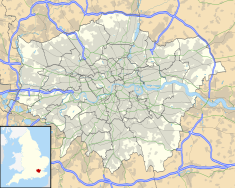Gordon House, Chelsea
| Gordon House | |
|---|---|
| Location | Chelsea, West London, England |
| Coordinates | 51°29′7.76″N 0°9′31.42″W / 51.4854889°N 0.1587278°WCoordinates: 51°29′7.76″N 0°9′31.42″W / 51.4854889°N 0.1587278°W |
| Built | 1809 |
| Architect | Thomas Leverton |
| Governing body | Leasehold privately owned, Freehold owned by the Royal Hospital Chelsea |
|
Listed Building – Grade II
|
|
| Official name: Gordon House | |
| Designated | 15 April 1969 |
| Reference no. | 1265844 |
Gordon House is a large 19th-century detached house in Chelsea, London, SW3. The house is sited in two acres of the south west corner of the grounds of the Royal Hospital Chelsea. It was designed by Thomas Leverton for Colonel James Willoughby Gordon. The house became part of the Royal Hospital following Gordon's death in 1851, and has recently been converted into a private residence.
The land on which Gordon House now stands was originally the site of Walpole House, the residence of Robert Walpole. After Walpole's death it was acquired by the Earl of Dunmore. Following Dunmore's death it was bought by merchant George Aufrere and was inherited by Aufrere's son-in-law, Lord Yarborough. The house was subsequently named for Lord Yarborough. Gian Lorenzo Bernini's sculpture Neptune and Triton stood in the octagon Summer house of Yarborough's house. Lord Yarborough sold the house to the British Government in 1808.
In 1807 the architect Sir John Soane had been made Clerk of Works of the Royal Hospital, and a new infirmary was proposed by the hospital's governor, Sir David Dundas, in the following year. A site was not chosen until June 1810, with a proposal by the hospital's physician that the recently re-acquired Yarborough House could be converted into an infirmary.
Soane opposed this, finding the house unsuitable for the proposed 80 berths, and he suggested two designs for detached buildings. Soane's designs benefited from a southern view over the River Thames, with the river air thought to be of benefit to the health of patients. Unbeknownst to Soane, his proposed infirmary scheme had already been rendered impossible due to the lease of the site to Colonel Willoughby Gordon for the construction of a villa.
In 1809 Colonel Gordon had acquired an 80-year lease of what had been a part of the Yarborough House grounds, on which he intended to build his villa. The lease was just over £52 per annum and it was obtained on the understanding that he spend £3,500 on the construction of the villa. Gordon commissioned Thomas Leverton to design the villa even before the lease was granted, and pulled down an existing pavilion in preparation. Soane tried in vain to alter the decision and position of the proposed villa to accommodate his infirmary.
...
Wikipedia

